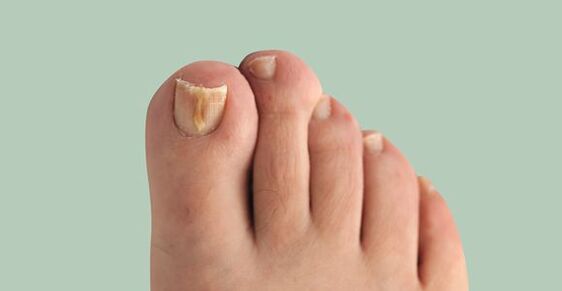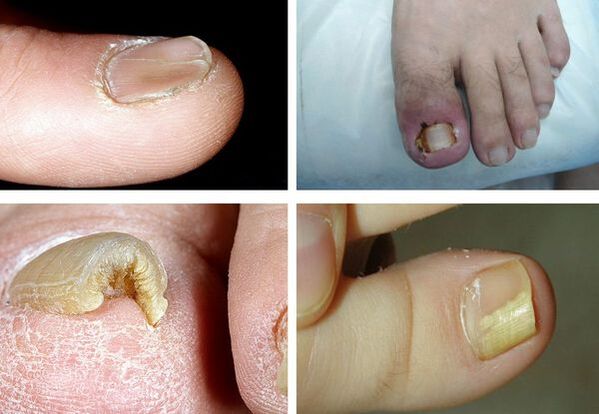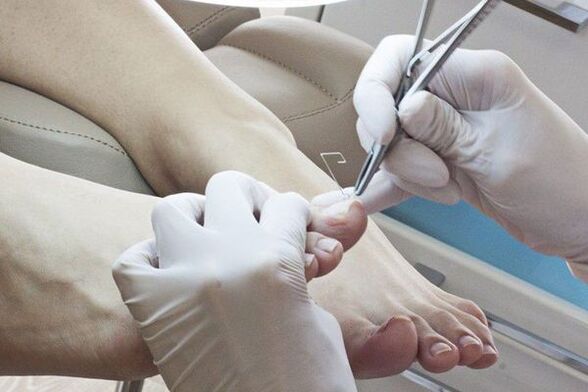Onyhycosis(Fungus nails) The damage is a fungal infection of nail plates and its surrounding structures: nail rollers, matrix (germinate nails) and nail bed.It manifests deformation and thickening of nails, change in their colors - nails become white or yellow.

This disease is often found.Onynchomicosis prevalence in Europeans, according to some reports, reaches 10-12%, exceeds the familiar indicators of the previous decade.In men, it occurs 1.5 times more often, but contact a doctor 2 times less than women.Older people are more often ill, the children are very rare.
The main problem in treating the disease is that patients come to see a dermatologist for a long time after the occurrence of first symptoms.Therefore, the pathological fungus recorded a large area, and the treatment is late.
Pathogenic mushrooms can only transmit a sick person.Very often, fungi infection occurs within the family, because the source does not reveal itself on time and adequate preventive measures are not carried out.
Causes of disease:Most often, direct contact with the patient or objects used (footwear, clothing, rugs in the bathroom, washing, manicure stock).Often the infection occurs during a visit to the gym, bathrooms, saunas and pools.
The development of the disease is facilitated by microsencies - cracks in interdigital folds that occur due to boring, increased sweating, dry skin, poor drying after water and straight feet procedures.
Mycosis for nails can also occur in the presence of conceptual diseases of the endocrine system (diabetes, hypothyroidism), vascular diseases, lymphostasis), immune disorders, as well as when using antibiotics, corticosteroid and cytostatic drugs.As a result of the above diseases, blood microcirculation in the nail area is disturbed and natural immunity is reduced, which contributes to the development of secondary infection.
Thosehomicosis causes the following types of fungi:
- Dermatophyte;
- Mushrooms in the form of yeast genus Candida;
- Molds.
Depending on the type of pathogen, the penetration of fungal infections and clinical images are different, so the therapy approaches are also different.
He influences the fungus on his feet 10 times more often than on his hand.In most cases, dermatophytes cause fungal (for example, Trichophyton Rubrum).The remaining cases are most often caused by inconsistent molds (aspergillus, scopularoopsis, fusarium).
If similar symptoms are discovered, contact your doctor.Don't self-synchronize - it's dangerous for your health!
Symptoms of onnicmicosis (nail fungus)
The longer the disease continues, the more pronounced its symptoms are becoming.Main signs ofychomicosis include:
- DYSCHROOMIA - Changing the color of the nail to yellow, black, green, gray or brown color (color type depends on the type of mushroom);
- onyholysis - separation of nail plates from the box;
- Changing the thickness of the nail plate;
- Gapalonichia - the power of the thickness of the plate and its softening;
- Koylonichia - nail looks concave, in the shape of a teaspoon;
- Pahionichia - thickening of nail plates, nail hypertrophy;
- Onichogrifosis - thickening, changing the nail plate color, twisted in the form of a beak;
- Changing the thickness of the nails (hypercheralatosis - thickening of nail beds);
- Change the surface of the nail plate: pits, furrows, reefs;
- Changing the nail and surrounding leather roller (paronychy - inflammation of a proximal nail roller).

It is important to note that it is not one of the symptoms pathogenic, ie unequivocally suitable for a particular pathogen, so it is impossible to determine the symptoms - additional inspections are needed.
Patogenesis of micromicosis (nail fungus)
The pathogenesis of the disease depends on how the fungus strikes the skin and nails.
Distal submarine type:If the fungus is introduced through the skin in the area of nail rollers or distal regions, then the spread of the infection occurs through the free edge of the nail in bed and further to the matrix.At the beginning, nail plate cannot change, but later, due to hypercheralatosis, gradually starting from nail beds and becomes yellowish.Foreign nail plate is gradually possible.
Superficial white type:If the foci of the nail is white, the entire nail plug appears over time.Nail sinks, disintegration, acquires a gray-brown shade.In this case, the matrix and epithelium on the nail list are not affected.There is no inflammation of the surrounding skin.
Proximal sub-top type:The mushroom can spread from leather and perologated rollers on the nail plate, and then to the matrix, reaching the distal parts of the nail plate.They appear on the nail in the nail in the area of the hole and the nail bed, the nail plate is separated.There is no pronounced inflammation of the bed or nail matrix.
Total dystrophic type:Affects the entire nail.The proximal areas of nail rollers disappear or thicken, so that nail table can no longer form and grow.
There isBiophysical concept of pathogenesis of onyxomicosis, which says that the disease appears the conflict between the two forces: a fungal colony that grows in the direction of the matrix, and the natural growth of the nail from the matrix to the distal edge.Therefore, the foot nail rate is crucial during an omicomicosis - faster nail grows, the earlier cure comes.Perhaps this is exactly what explains a small prevalence of disease in children, because their nails grow faster than in adults and older people.
Classification and stages of the development of ONY micromicosis (nail fungus)
There is the following classification of ONY micromicosis:
- Distal submarine;
- superficial white;
- Proximal sub-upper;
- Totally distrophy.

According to the 1970 classification. Years:
- Normotorophic: in the thickness of the nail, yellowish and white bars, but the shape of the nail plate does not change, there is no hypercheralatose of the submarine;
- Hypertrophic:The nail plate becomes yellow, thickened due to the hypercheralatose of the submarine, becomes broken, with serrated edges;
- Dystrophic:There is a thinning and removal of nail plate from nail beds with formation of gaps.
Complications of onićmikosu (nail fungus)
With long-standing ofychomikosome, the risk of development increasesdiabetic foot(formation of trophic chirols on their feet) andGangrena, If the patient has diabetes or vascular diseases of the lower extremities.

In immunosuppressive conditions (primary and secondary immunodefinals), mushrooms can spread to the skin, internal organs and cause body to allergy.This can manifest the skin rash to the development of bronchial asthma.
Diagnosis of ofychomicosis (nail fungus)
Before the diagnosis of an omicmicosis is made, it is necessary to explain how to properly compile the study material (the patient works independently or prepares the nails before diagnostics).Prior to the fence of the study material, it is necessary to treat the nail plane with 70% alcohol, so there is no obstruction of other bacteria.
Material collection method varies depending on the form of onikmikozys:
- Superficial form- Make scraping from nail plate;
- Remote form- It is necessary to scrape from the nail bed and a piece of nail plate;
- Proximal pattern of submarines- The material is driven by exercise or a nail biopsy or scraping from the nail bed.
The fastest way to determine pathological fungus in nails ismicroscopy.Technique: The studio material is treated with the solution of alkali to dissolve keratin.In order to make the fungus better, the inks are added to Alkali.Further, study the resulting medicine below the microscope.
This research method is the fastest and most objective.Sensitivity is up to 80%.Disadvantages of methods include the fact that when it uses it, it is impossible to determine the type of pathogen.
Bacteriological sowing: is an additional method of diagnosis of an omicomicosis.The material shines on a special environment and interpretes the result under a microscope after 2-3 weeks.This method allows you to establish the type of pathogenic - this helps determine the treatment tactics and when choosing medications with sensitivity.But the lack of study is that it takes a lot of time, and its sensitivity is only 30-50%.
Biopsy: With the help of the scalpel and using anesthesia, nail and nail beds are cut off.The material is immersed in the formaldehyde solution and has been sent to a histological overview of the laboratory.The advantages of this method are very sensitive and allows you to determine the presence of pathological fungus in the material.
Cons: It is impossible to identify pathogen, as well as establish the sustainability of microorganisms, high costs and complexity of the method.
Genodiagnostics: Molecular method of biological research (PCR).This is one of the new and very sensitive methods for Diagnostics of Onikmikozy-with the help of that, DNK pathogen is revealed.It is recommended to introduce this type of diagnosis in those medical institutions that have PCR laboratories, but currently test systems for identifying dermatophytes and mushrooms and molds only plan to introduce the laboratory.The method allows you to specify the type of pathogen, and its sensitivity is from 80-90%.Against - High costs, inaccessibility, lack of technological standards and the complexity of execution.
In practice, more and more doctors are introducedDermatoscopy.With this method you can estimate the color change and nail structure, the condition of the surrounding structures.The dermatoscopic overview allows you more precise to estimate the depth of nail plate damage and more precisely calculate the seriousness ofychomicosis.
Healing ofychomicosis (nail fungus)
There are several types of treatment for onyhycosis:
- Local therapy.
- System therapy.
- Combined therapy.
- Corrective therapy.
Local therapyThis includes the application of drugs on the nail plate and nail rollers.Indications for local therapy:
- Limited form of nail plate damage.
- There are contraindications for the appointment of systemic drugs: hypersensitivity, liver disease, kidney, pregnancy, breastfeeding.
The advantages of this therapy are to form high concentrations of the therapeutic agent on the surface of the nail, which does not penetrate the bloodstream.There are no side effects of the use of antifungal drugs - nausea, abhorriment, abdominal pain.The lack of a method is that the healing substance does not always fall into pathogen habitat, especially if the mushrooms are in bed or nail matrix.This, in turn can lead to the inefficiency of treatment.This type of treatment is very time -konsuming, because before applying the medicine, it is necessary to remove the affected part of the nail.
Ways of removal of affected nails:
- Mechanical removal with files, bars or drills.
- With the help of keratolytic plasters.Before applying the keratolitical patch, the skin around the nail is a sealed patch, the mass of patches (urea salicylic acid) is applied at the top and sealed with sticky plaster.The mass of patch changes every 2-3 days.After each removal, the affected part of the nail is mechanically removed.
- Surgical.This operation is very painful and traumatic, because when removing nail plate, the germination zone can be damaged, which leads to growth in deformed nails.

Local antifungal agents are used after removing the affected nail plate.AntimacoticsDistinguish place of application:
- It applies to the nail: varnishes;
- Apply to rollers: creams, fats, solutions.
The most common tool for local use is a 1% solution to the drug of the Allumna Group that has a probative basis in treatment based on corrking meta-analysis.This tool has a water base that contributes to the better penetration of antifungal substances to the destruction site.The varnishes have an dehydrated base that reduces the penetration of the drug into deep layers.Therefore, dermatologists believe that the use of varnishes unsatisfactory and increasingly frequently preferred tools for bordered into water.
To achieve the result of local therapy, it is necessary to observe the treatment regime, it is important that the patient is responsible, consistent and patient.The duration of therapy can reach 12 months.
System therapyIt allows antifungal medicine to penetrate through the blood on the lie, even if the bed and nail matrix are affected.The high concentration of the drug remains long in the lesion after the end of use.The shortcomings of this type of treatment are related to the risk of lateral and toxic effects.
Indications for system therapy:
- Common forms of nail plate damage.
- Lack of local therapy (this is after six months of treatment ony micromicosis on their hands and 9-12 months of onypromicosis of foot, there was no growing healthy nails).
To determine the treatment tactics, the clinical index of the seriousness of Ony micromicosis is used.It is used as a therapeutic standard in various countries of the world.
MedicationsYou can classify for onnikmikoses as follows:
- Antimicotics - have an antifungal effect;
- Antiseptics - have antifungal and antibacterial effects.Seldom used, only if there are no other antifungal means;
- Multi-component - In addition to an antifungal agent, contain other medications, such as anti-inflammatory.
Medication prescribing medicine:
- Standard - Daily application of medications during the prescribed treatment period;
- Abbreviated - The treatment period was shortened, can be performed by conventional doses or increased;
- Interruption - treatment is prescribed to several short courses, intervals between courses are equal to the duration of courses;
- The impulse therapy is prescribed to several short courses, intervals between courses are higher than the duration of the courses.
Antifungal medications are divided into an active substance:
- Triazols;
- Allumnis;
- Morfolins.
System therapies are currently usedOnly medications for thirds.
With combined therapyLocal and systemic treatment are carried out at the same time.The combined therapy is used if the efficiency of system therapy is needed and reduce periods of treatment.
Corrective therapy(Treatment of simultaneous diseases): To select the treatment regime, it is necessary to evaluate the general some state of the body.Diseases such as circulation disorders in the limbs can reduce access to an antifungal agent on a lesion.Therefore, drugs are prescribed that improve trophic tissue.
Due to the toxic effects of systematic antifungal drugs, it is necessary to exclude liver diseases and, if necessary, prescribe hepatoprosecters.
Forecast.Prevention
The sooner the patient contacts the doctor with signs of finger lesions, faster the disease will be a healed and renovated nail panel.With long-term processes with grasping the entire nail, onychomicosis treatment can be long, but in all recommendations, recovery often appears.If there are contraindications for system therapy, long -t -t -t-support treatment with local medications is needed.
For preventionIt is necessary to adhere to the rules of personal hygiene and reduce the possibility of re-infection:
- Try wearing comfortable and tall shoes (to prevent increased leg sweat);
- It is recommended to change socks and tights per day;
- Use only individual shoes.Those passing treatment for onychomicos must be treated at the beginning of treatment, at least once a month throughout the treatment period and after its end;
- If necessary, use your leg antiperspirants;
- Use an individual nail care set (scissors, saws);
- Before and after visiting public places (pool, bathroom, sports hall), use antifungal external products (spray, cream and pens);
- To identify the source of fungal infection in the family and treat yourself at the same time.
It is recommended to periodically implement antifungal processing of personal belongings, shoes, bathroom, floors and rugs.For these purposes you can use a 40% acetic acid solution, 1% alcoholic solution antiseptics (prescription prescribes a doctor), disinfection solutions.Underwear can be cooked in 1-2% of soap solution for 20-30 minutes, iron at maximum temperature.


















